| Reviews & Columns |
|
Reviews DVD TV on DVD Blu-ray 4K UHD International DVDs In Theaters Reviews by Studio Video Games Features Collector Series DVDs Easter Egg Database Interviews DVD Talk Radio Feature Articles Columns Anime Talk DVD Savant Horror DVDs The M.O.D. Squad Art House HD Talk Silent DVD
|
DVD Talk Forum |
|
|
| Resources |
|
DVD Price Search Customer Service #'s RCE Info Links |
|
Columns
|
|
|
Howl's Moving Castle (GKIDS Release)
GKIDS Films // PG // October 17, 2017
List Price: $29.95 [Buy now and save at Amazon]
The Film:
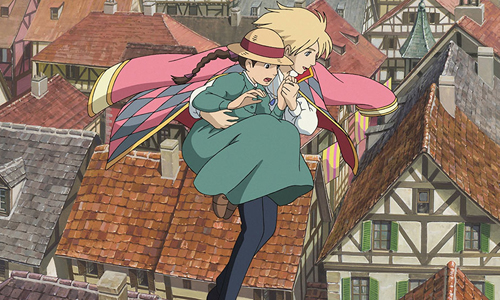
Hayao Miyazaki created his first truly original piece of animation in the mid-‘80s with the steampunk-esque fantasy Nausicaa of the Valley of the Wind, an adaptation of his own manga book series, marking the first collaborative project to come out of what would transform into the now iconic Studio Ghibli. Twenty years of world-building and characterization followed before the release of Howl's Moving Castle, a broad-scoped tale of wizards and warfare given intimacy by a curse placed on a common hat maker. Creativity runs rampant throughout all of Miyazaki's works, usually offering visual and emotional delights unlike those that people have seen before, even those familiar with their body of work. Howl's Moving Castle marches to the beat of a different drummer: whether intentional or not, the designs of locations, machines, and surreal transformations overly mimic those in previous works from Miyazaki, resulting in gorgeous, vibrant, yet relatively uninventive journey through familiar sights and sounds.
Adding to the cadre of determined heroines widespread in the director's work, the focus of Howl's Moving Castle -- an adaptation of Diana Wynne Jones's fantasy novel -- falls on Sophie, a youthful hatter who's trying to keep the family business afloat. The world she inhabits seems fairly normal on the surface, one caught up in the bluster and turmoil of war, until the sight of a mechanized, walking castle is treated like a commonplace occurrence. It's the dwelling of Howl, a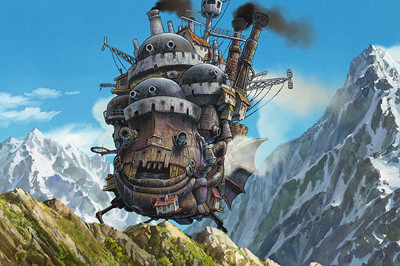 powerful and handsome wizard who draws the attention of the opposite sex everywhere he travels, extending his reputation far and wide. A chance encounter brings Sophie and Howl together in the city streets, then promptly separates them; however, the same encounter also results in Sophie being targeted by the Witch of the Waste, enduring a curse that instantly transforms her into an old woman. In search of new fulfillment for her life, Sophie flees into the prairie realm of witches and wizards, and soon comes across the familiar clockwork castle roaming the lands.
powerful and handsome wizard who draws the attention of the opposite sex everywhere he travels, extending his reputation far and wide. A chance encounter brings Sophie and Howl together in the city streets, then promptly separates them; however, the same encounter also results in Sophie being targeted by the Witch of the Waste, enduring a curse that instantly transforms her into an old woman. In search of new fulfillment for her life, Sophie flees into the prairie realm of witches and wizards, and soon comes across the familiar clockwork castle roaming the lands.
The cinema of Hayao Miyazaki usually possesses a conceptual hook that's revealed at or near the beginning of his stories, designed to intrigue the audience almost immediately and provide unique context for everything to follow. Sometimes, they're blatant and tangible, like the requirement for a coming-of-age witch to live in a human city or the transmission of a morally corrosive curse through a demon's attack; other times, they're tonal and interpretive, like fazing into the nightmarish atmosphere of a spirit realm or the apocalyptic aura that fills a toxic jungle. Howl's Moving Castle has a tougher time reeling in the audience with its pair of hooks, the moving castle and the old-age spell, and it's due in large part to them being overtly purpose-driven apparatus within its plot. Little depth is explored behind the castle's creation as an in-motion sanctuary from war and Sophie's effortless acceptance of suddenly having the appearance of an old woman, both comparatively shallow moving parts when compared to those in Miyazaki's prior films.
Perhaps that's a pitfall of Miyazaki wanting to put the distinctive Ghibli spin on an established source that contains a lot of material within their wheelhouse, where a desire to stay true to the fantasy novel swirls together with too many similarities to their prior creations. Howl's Moving Castle comes across as a melting pot of recognizable elements from the studio's other stories, from the European-inspired coastal city and paddle-winged aerial battleships to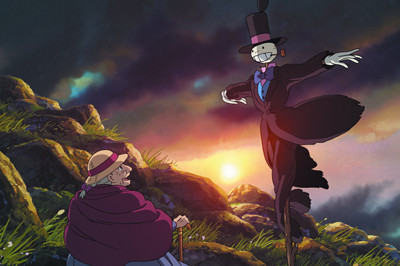 disproportioned, broad-faced witches and people transforming into flying bird-human hybrids. Touches of cohesiveness between the films to tie them together -- to create the faint illusion of a shared universe -- can be welcome, but part of the joy in watching Ghibli's body of work comes in the fresh inventions flickering to life through their artistry. Wizards and witches are integrated into the affairs of humanity in stimulating ways, and the subtleties of Sophie's curse changing her aged appearance based on her contentment can be clever, but they're buried underneath this familiar world-building that takes away from the story's earnest imagination.
disproportioned, broad-faced witches and people transforming into flying bird-human hybrids. Touches of cohesiveness between the films to tie them together -- to create the faint illusion of a shared universe -- can be welcome, but part of the joy in watching Ghibli's body of work comes in the fresh inventions flickering to life through their artistry. Wizards and witches are integrated into the affairs of humanity in stimulating ways, and the subtleties of Sophie's curse changing her aged appearance based on her contentment can be clever, but they're buried underneath this familiar world-building that takes away from the story's earnest imagination.
This burdened flatness carries over to the characters in Howl's Moving Castle, but only to the humans involved. A tophat-wearing scarecrow bounces around on a thin stick body with a turnip jammed onto the top as its head, as well as a fire demon within Howl's clockwork home that keeps the place operating under obligation to his wizard master, and they're the ones who leave the studio's creative thumbprint on the film with jubilant, yet restrained personality and quirky functionality. The key relationship between Sophie and Howl rings hollow, though, partly caused by an absence of exposed depth -- also viewed as an invitation to read what's going on under their surfaces -- but also impacted by what seems like Studio Ghibli's attempt at more conventional anime-romance elements; the lanky, handsome, swoopy-haired Howl stays aloof and mysterious while the undesirable, yet plucky Sophie builds affections for him while dealing with the ailments of her curse. Based on codependence and the broad strokes of insecurity, a bond forms between them that neglects sincere chemistry and complexity.
Unsurprisingly, much of what's important in Howl's Moving Castle takes place within the rickety, steam-puffing space of the wizard's home, a clever contraption that transcends time and space with its color-coded magical door that opens to areas across the globe. The conflicts of the story happen far outside the "castle", hinged on the enchantments that keep it hidden from threats and the ongoing war between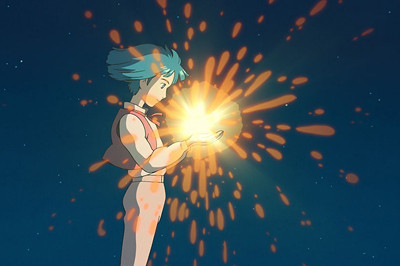 kingdoms that demands the participation of those who use magic, lending a static and concealed energy to the drama happening within Howl's sanctuary. It's a journey that, ironically, has little perceptible forward motion, where themes of avoiding war also results in a story that, much like the focal castle on legs, wanders throughout the peaceful countryside away from the film's intrigues. There's always something to anticipate in Miyazaki's films -- fulfilling the prophecy of the valley of the wind, locating a castle in the sky, escaping a spirit realm -- yet that doesn't really exist here outside of observing Howl's distant interferences with the war and wondering if Sophie's curse has a cure.
kingdoms that demands the participation of those who use magic, lending a static and concealed energy to the drama happening within Howl's sanctuary. It's a journey that, ironically, has little perceptible forward motion, where themes of avoiding war also results in a story that, much like the focal castle on legs, wanders throughout the peaceful countryside away from the film's intrigues. There's always something to anticipate in Miyazaki's films -- fulfilling the prophecy of the valley of the wind, locating a castle in the sky, escaping a spirit realm -- yet that doesn't really exist here outside of observing Howl's distant interferences with the war and wondering if Sophie's curse has a cure.
Howl's Moving Castle does have a destination, though, one that justifies the intentional evasions of the narrative with surreal imagery and boldly telegraphed visualizations of its antiwar themes. Explosions, sputtering machines, and metaphysical excursions through memories of the past form into a coherent, striking manifestation of raw emotion and raised stakes for all involved, elevated by Studio Ghibli's ability to unite reality with fantasy and lend tangibility to the other-worldly. Granted, this also doesn't come without niggling issues, since many of the final act's problems are ignited by misguided trust being placed in someone who, under any circumstances, really shouldn't be trusted or left to their own devices. Rickety plot devices aside, Howl's Moving Castle ultimately knows what emotional gears need to be put in motion for it to succeed, and it does so with the kind of cathartic grandness one would expect from Miyazaki, in turns impish and melancholic as it brings the story of the wizard and the hatter to a close. Even the least innovative of the director's films can still cast an effective spell or two.
The Blu-ray:
Shout Factory and GKIDS amble over into the Blu-ray realm of Howl's Moving Castle with a two-disc presentation, including strikingly familiar artwork on the front that's only differentiated by the change in branding on the top border. The interior artwork tends to be another story, with smartly-designed discs and a fitting inlay still on the reverse of the cover. GKIDS have also included their own standard-definition DVD for Disc Two, as well as a thin, exclusive Booklet with promo photos and two textual blurbs from producer Toshio Suzuki.
Video and Audio:
As I mentioned in my latest review of My Neighbor Totoro, the fine folks at GKIDS have taken over the rights to distribute all of Studio Ghibli's films on the home-media format, several of which needed some sprucing up to improve upon Disney's initial releases of the films; subtitle translations here, HD audio additions there, and so on. A few, however, really didn't require any additional cleaning up or options, sporting delightful audiovisual merits (many sourced in Japan) and containing proper subtitle translations. Howl's Moving Castle is yet another of those films: seeing as how it's only a little over ten years old, the picture and sound were both incredibly well-done (check out Randy Miller III's review here), but the choice for either dubtitles sourced from the English track or traditional Japanese-translated subtitles made for a robust, agreeable presentation of Hayao Miyazaki's film. Spot-checking between the two releases indicates that the visual transfer, the audio tracks, and the subtitles of the GKIDS release function just about identically to those from Disney's release.
Going into a little more detail about those, the 1.85:1-framed, 1080p AVC transfer is simply staggering, predictable or not based off the film's age. Brush strokes and all the black lines are delicate and nuanced, while ornate details in clothing, food, and décor are delicate and sharp. Colors are bold yet mindful of the artwork's desired shading, while the contrast levels yield shadowy corners and darkened landscape that are both deep yet constantly aware of all details within. No issues with compression or digital presence, and the cinematic flow of the artwork is impeccable. Both the English and Japanese language tracks are presented in 5.1 DTS-HD Master Audio treatments that contain the same convincing, hearty representations of warfare and steampunk-infused machinery one could expect, sporting tight bass response with rattling engines and explosions of all kinds. They also project delightfully nuanced little details: the crackling of a fire and sizzle of cooking food, the clinks of machinery and huffs of steam, the click of the magic door's color swatch and the creak of door hinges. A feast for the eyes and ears.
A note about the subtitles: the standard English subs are not dubtitles; however, the English SDH titles are. One example of the differences between the tracks comes in referencing the bakery that Sophie's traveling to when she encounters Howl for the first time: in the SDH dubtitles, after Howl states that he'll be her escort "this evening", her destination is referred to as just "the bakery"; in the traditional English subtitle option, there's no reference to "this evening" and Sophie's location is "Cesari's".
Special Features:
Those who want a slightly more comprehensive slate of extras will want to take a look at the GKIDS release of Howl's Moving Castle, though, as it includes a few bonus materials that weren't available the first time around in the US but have been available in other regions. The bits-‘n-pieces found on Disney's Blu-ray have mostly been carried over onto the GKIDS release, which are: Feature-Length Storyboards (1:59:13, 16x9 HD); Behind the Microphone (9:02, 4x3); and Miyazaki's Visit to Pixar (16:29, 4x3). They've also included a comprehensive collection of Original Theatrical Trailers (8:17, 16x9 HD) and TV Spots (8:24, 4x and TV Spots (8:24, 4x3). You'll notice that the Interview with Pete Doctor is missing.
Here's the neat part of the new Blu-ray: there are three other special features, two in Japanese with English subtitles and one in English, and all are worth pursuing. The first in Japanses is The Birth Story of the Film Soundtrack (27:31, 4x3), which fluctuates between general discussion about the production itself and the focus placed on sound aspects. Sketches, reference recording footage, even a shot of the original novel printed in Japanese (with the spine reversed) accompany a sitdown conversation with three of the sound designers responsible for the film, moderated by Tatsuya Gashuin, the original voice actor behind Calcifer. The second, Explanation of CG (19:37, 4x3), is an overwhelmingly in-depth look at all the components that go into making certain computer-generated elements of the film look like traditional animation, paired with comparisons and a lot of technical visuals revealing the modeling.
GKIDS have also included an Interview with Diana Wynne Jones (7:34, 4x3), the author of the original book, whose critiques of the differences between her writing and the film can be ciphered from her highly amiable discussion. She tackles subjects in a Q&A fashion with a voiceless interviewer, paired with sketches to help her descriptions along a bit, and she touches on material and visuals that weren't in the book alongside her delight in seeing how Miyazaki realized what was.
Final Thoughts:
Howl's Moving Castle exhibits the same striking visual enormity of other films from Hayao Miyazaki, both updated for the modern era and uniquely antiquated to echo their other works, and possesses sprawling scope and intriguing mysticism through its world-building. As an adaptation of a fantasy novel and the meeting place for twenty years of innovation under the Studio Ghibli banner, however, it lack the same flickers of novelty and creative exploration, rehashing aesthetic and storytelling concepts and tapping into "classic" romantic overtones that aren't quite justified by the lusterless depth poured into the primary characters. In comparison to most western pieces of animation, it's a flawed yet bewitching fantasy with bold antiwar themes that give it plenty of meaning; in comparison to Studio Ghibli's other endearing and endlessly imaginative masterworks, however, there's an absence of magic that keeps it from ascending to the same lofty heights. GKIDS's Blu-ray looks and sounds tremendous, and comes with the same tentpole bonus features alongside a few new ones for folks in our territory. Fans of the film who haven't made the jump to HD yet will certainly want to do so with this release. Very strongly Recommended.
Thomas Spurlin, Staff Reviewer -- DVDTalk Reviews | Personal Blog/Site

Hayao Miyazaki created his first truly original piece of animation in the mid-‘80s with the steampunk-esque fantasy Nausicaa of the Valley of the Wind, an adaptation of his own manga book series, marking the first collaborative project to come out of what would transform into the now iconic Studio Ghibli. Twenty years of world-building and characterization followed before the release of Howl's Moving Castle, a broad-scoped tale of wizards and warfare given intimacy by a curse placed on a common hat maker. Creativity runs rampant throughout all of Miyazaki's works, usually offering visual and emotional delights unlike those that people have seen before, even those familiar with their body of work. Howl's Moving Castle marches to the beat of a different drummer: whether intentional or not, the designs of locations, machines, and surreal transformations overly mimic those in previous works from Miyazaki, resulting in gorgeous, vibrant, yet relatively uninventive journey through familiar sights and sounds.
Adding to the cadre of determined heroines widespread in the director's work, the focus of Howl's Moving Castle -- an adaptation of Diana Wynne Jones's fantasy novel -- falls on Sophie, a youthful hatter who's trying to keep the family business afloat. The world she inhabits seems fairly normal on the surface, one caught up in the bluster and turmoil of war, until the sight of a mechanized, walking castle is treated like a commonplace occurrence. It's the dwelling of Howl, a
 powerful and handsome wizard who draws the attention of the opposite sex everywhere he travels, extending his reputation far and wide. A chance encounter brings Sophie and Howl together in the city streets, then promptly separates them; however, the same encounter also results in Sophie being targeted by the Witch of the Waste, enduring a curse that instantly transforms her into an old woman. In search of new fulfillment for her life, Sophie flees into the prairie realm of witches and wizards, and soon comes across the familiar clockwork castle roaming the lands.
powerful and handsome wizard who draws the attention of the opposite sex everywhere he travels, extending his reputation far and wide. A chance encounter brings Sophie and Howl together in the city streets, then promptly separates them; however, the same encounter also results in Sophie being targeted by the Witch of the Waste, enduring a curse that instantly transforms her into an old woman. In search of new fulfillment for her life, Sophie flees into the prairie realm of witches and wizards, and soon comes across the familiar clockwork castle roaming the lands. The cinema of Hayao Miyazaki usually possesses a conceptual hook that's revealed at or near the beginning of his stories, designed to intrigue the audience almost immediately and provide unique context for everything to follow. Sometimes, they're blatant and tangible, like the requirement for a coming-of-age witch to live in a human city or the transmission of a morally corrosive curse through a demon's attack; other times, they're tonal and interpretive, like fazing into the nightmarish atmosphere of a spirit realm or the apocalyptic aura that fills a toxic jungle. Howl's Moving Castle has a tougher time reeling in the audience with its pair of hooks, the moving castle and the old-age spell, and it's due in large part to them being overtly purpose-driven apparatus within its plot. Little depth is explored behind the castle's creation as an in-motion sanctuary from war and Sophie's effortless acceptance of suddenly having the appearance of an old woman, both comparatively shallow moving parts when compared to those in Miyazaki's prior films.
Perhaps that's a pitfall of Miyazaki wanting to put the distinctive Ghibli spin on an established source that contains a lot of material within their wheelhouse, where a desire to stay true to the fantasy novel swirls together with too many similarities to their prior creations. Howl's Moving Castle comes across as a melting pot of recognizable elements from the studio's other stories, from the European-inspired coastal city and paddle-winged aerial battleships to
 disproportioned, broad-faced witches and people transforming into flying bird-human hybrids. Touches of cohesiveness between the films to tie them together -- to create the faint illusion of a shared universe -- can be welcome, but part of the joy in watching Ghibli's body of work comes in the fresh inventions flickering to life through their artistry. Wizards and witches are integrated into the affairs of humanity in stimulating ways, and the subtleties of Sophie's curse changing her aged appearance based on her contentment can be clever, but they're buried underneath this familiar world-building that takes away from the story's earnest imagination.
disproportioned, broad-faced witches and people transforming into flying bird-human hybrids. Touches of cohesiveness between the films to tie them together -- to create the faint illusion of a shared universe -- can be welcome, but part of the joy in watching Ghibli's body of work comes in the fresh inventions flickering to life through their artistry. Wizards and witches are integrated into the affairs of humanity in stimulating ways, and the subtleties of Sophie's curse changing her aged appearance based on her contentment can be clever, but they're buried underneath this familiar world-building that takes away from the story's earnest imagination. This burdened flatness carries over to the characters in Howl's Moving Castle, but only to the humans involved. A tophat-wearing scarecrow bounces around on a thin stick body with a turnip jammed onto the top as its head, as well as a fire demon within Howl's clockwork home that keeps the place operating under obligation to his wizard master, and they're the ones who leave the studio's creative thumbprint on the film with jubilant, yet restrained personality and quirky functionality. The key relationship between Sophie and Howl rings hollow, though, partly caused by an absence of exposed depth -- also viewed as an invitation to read what's going on under their surfaces -- but also impacted by what seems like Studio Ghibli's attempt at more conventional anime-romance elements; the lanky, handsome, swoopy-haired Howl stays aloof and mysterious while the undesirable, yet plucky Sophie builds affections for him while dealing with the ailments of her curse. Based on codependence and the broad strokes of insecurity, a bond forms between them that neglects sincere chemistry and complexity.
Unsurprisingly, much of what's important in Howl's Moving Castle takes place within the rickety, steam-puffing space of the wizard's home, a clever contraption that transcends time and space with its color-coded magical door that opens to areas across the globe. The conflicts of the story happen far outside the "castle", hinged on the enchantments that keep it hidden from threats and the ongoing war between
 kingdoms that demands the participation of those who use magic, lending a static and concealed energy to the drama happening within Howl's sanctuary. It's a journey that, ironically, has little perceptible forward motion, where themes of avoiding war also results in a story that, much like the focal castle on legs, wanders throughout the peaceful countryside away from the film's intrigues. There's always something to anticipate in Miyazaki's films -- fulfilling the prophecy of the valley of the wind, locating a castle in the sky, escaping a spirit realm -- yet that doesn't really exist here outside of observing Howl's distant interferences with the war and wondering if Sophie's curse has a cure.
kingdoms that demands the participation of those who use magic, lending a static and concealed energy to the drama happening within Howl's sanctuary. It's a journey that, ironically, has little perceptible forward motion, where themes of avoiding war also results in a story that, much like the focal castle on legs, wanders throughout the peaceful countryside away from the film's intrigues. There's always something to anticipate in Miyazaki's films -- fulfilling the prophecy of the valley of the wind, locating a castle in the sky, escaping a spirit realm -- yet that doesn't really exist here outside of observing Howl's distant interferences with the war and wondering if Sophie's curse has a cure. Howl's Moving Castle does have a destination, though, one that justifies the intentional evasions of the narrative with surreal imagery and boldly telegraphed visualizations of its antiwar themes. Explosions, sputtering machines, and metaphysical excursions through memories of the past form into a coherent, striking manifestation of raw emotion and raised stakes for all involved, elevated by Studio Ghibli's ability to unite reality with fantasy and lend tangibility to the other-worldly. Granted, this also doesn't come without niggling issues, since many of the final act's problems are ignited by misguided trust being placed in someone who, under any circumstances, really shouldn't be trusted or left to their own devices. Rickety plot devices aside, Howl's Moving Castle ultimately knows what emotional gears need to be put in motion for it to succeed, and it does so with the kind of cathartic grandness one would expect from Miyazaki, in turns impish and melancholic as it brings the story of the wizard and the hatter to a close. Even the least innovative of the director's films can still cast an effective spell or two.
The Blu-ray:
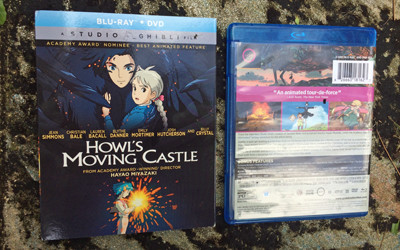 | 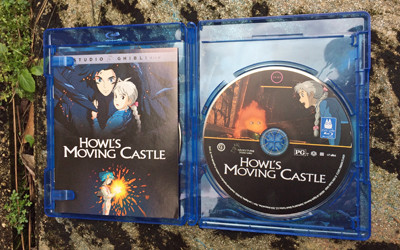 |
Shout Factory and GKIDS amble over into the Blu-ray realm of Howl's Moving Castle with a two-disc presentation, including strikingly familiar artwork on the front that's only differentiated by the change in branding on the top border. The interior artwork tends to be another story, with smartly-designed discs and a fitting inlay still on the reverse of the cover. GKIDS have also included their own standard-definition DVD for Disc Two, as well as a thin, exclusive Booklet with promo photos and two textual blurbs from producer Toshio Suzuki.
Video and Audio:
As I mentioned in my latest review of My Neighbor Totoro, the fine folks at GKIDS have taken over the rights to distribute all of Studio Ghibli's films on the home-media format, several of which needed some sprucing up to improve upon Disney's initial releases of the films; subtitle translations here, HD audio additions there, and so on. A few, however, really didn't require any additional cleaning up or options, sporting delightful audiovisual merits (many sourced in Japan) and containing proper subtitle translations. Howl's Moving Castle is yet another of those films: seeing as how it's only a little over ten years old, the picture and sound were both incredibly well-done (check out Randy Miller III's review here), but the choice for either dubtitles sourced from the English track or traditional Japanese-translated subtitles made for a robust, agreeable presentation of Hayao Miyazaki's film. Spot-checking between the two releases indicates that the visual transfer, the audio tracks, and the subtitles of the GKIDS release function just about identically to those from Disney's release.
Going into a little more detail about those, the 1.85:1-framed, 1080p AVC transfer is simply staggering, predictable or not based off the film's age. Brush strokes and all the black lines are delicate and nuanced, while ornate details in clothing, food, and décor are delicate and sharp. Colors are bold yet mindful of the artwork's desired shading, while the contrast levels yield shadowy corners and darkened landscape that are both deep yet constantly aware of all details within. No issues with compression or digital presence, and the cinematic flow of the artwork is impeccable. Both the English and Japanese language tracks are presented in 5.1 DTS-HD Master Audio treatments that contain the same convincing, hearty representations of warfare and steampunk-infused machinery one could expect, sporting tight bass response with rattling engines and explosions of all kinds. They also project delightfully nuanced little details: the crackling of a fire and sizzle of cooking food, the clinks of machinery and huffs of steam, the click of the magic door's color swatch and the creak of door hinges. A feast for the eyes and ears.
A note about the subtitles: the standard English subs are not dubtitles; however, the English SDH titles are. One example of the differences between the tracks comes in referencing the bakery that Sophie's traveling to when she encounters Howl for the first time: in the SDH dubtitles, after Howl states that he'll be her escort "this evening", her destination is referred to as just "the bakery"; in the traditional English subtitle option, there's no reference to "this evening" and Sophie's location is "Cesari's".
Special Features:
Those who want a slightly more comprehensive slate of extras will want to take a look at the GKIDS release of Howl's Moving Castle, though, as it includes a few bonus materials that weren't available the first time around in the US but have been available in other regions. The bits-‘n-pieces found on Disney's Blu-ray have mostly been carried over onto the GKIDS release, which are: Feature-Length Storyboards (1:59:13, 16x9 HD); Behind the Microphone (9:02, 4x3); and Miyazaki's Visit to Pixar (16:29, 4x3). They've also included a comprehensive collection of Original Theatrical Trailers (8:17, 16x9 HD) and TV Spots (8:24, 4x and TV Spots (8:24, 4x3). You'll notice that the Interview with Pete Doctor is missing.
Here's the neat part of the new Blu-ray: there are three other special features, two in Japanese with English subtitles and one in English, and all are worth pursuing. The first in Japanses is The Birth Story of the Film Soundtrack (27:31, 4x3), which fluctuates between general discussion about the production itself and the focus placed on sound aspects. Sketches, reference recording footage, even a shot of the original novel printed in Japanese (with the spine reversed) accompany a sitdown conversation with three of the sound designers responsible for the film, moderated by Tatsuya Gashuin, the original voice actor behind Calcifer. The second, Explanation of CG (19:37, 4x3), is an overwhelmingly in-depth look at all the components that go into making certain computer-generated elements of the film look like traditional animation, paired with comparisons and a lot of technical visuals revealing the modeling.
GKIDS have also included an Interview with Diana Wynne Jones (7:34, 4x3), the author of the original book, whose critiques of the differences between her writing and the film can be ciphered from her highly amiable discussion. She tackles subjects in a Q&A fashion with a voiceless interviewer, paired with sketches to help her descriptions along a bit, and she touches on material and visuals that weren't in the book alongside her delight in seeing how Miyazaki realized what was.
Final Thoughts:
Howl's Moving Castle exhibits the same striking visual enormity of other films from Hayao Miyazaki, both updated for the modern era and uniquely antiquated to echo their other works, and possesses sprawling scope and intriguing mysticism through its world-building. As an adaptation of a fantasy novel and the meeting place for twenty years of innovation under the Studio Ghibli banner, however, it lack the same flickers of novelty and creative exploration, rehashing aesthetic and storytelling concepts and tapping into "classic" romantic overtones that aren't quite justified by the lusterless depth poured into the primary characters. In comparison to most western pieces of animation, it's a flawed yet bewitching fantasy with bold antiwar themes that give it plenty of meaning; in comparison to Studio Ghibli's other endearing and endlessly imaginative masterworks, however, there's an absence of magic that keeps it from ascending to the same lofty heights. GKIDS's Blu-ray looks and sounds tremendous, and comes with the same tentpole bonus features alongside a few new ones for folks in our territory. Fans of the film who haven't made the jump to HD yet will certainly want to do so with this release. Very strongly Recommended.
|
| Popular Reviews |
| Sponsored Links |
|
|
| Sponsored Links |
|
|
| Release List | Reviews | Shop | Newsletter | Forum | DVD Giveaways | Blu-Ray | Advertise |
|
Copyright 2024 DVDTalk.com All Rights Reserved. Legal Info, Privacy Policy, Terms of Use,
Manage Preferences,
Your Privacy Choices | |||||||













